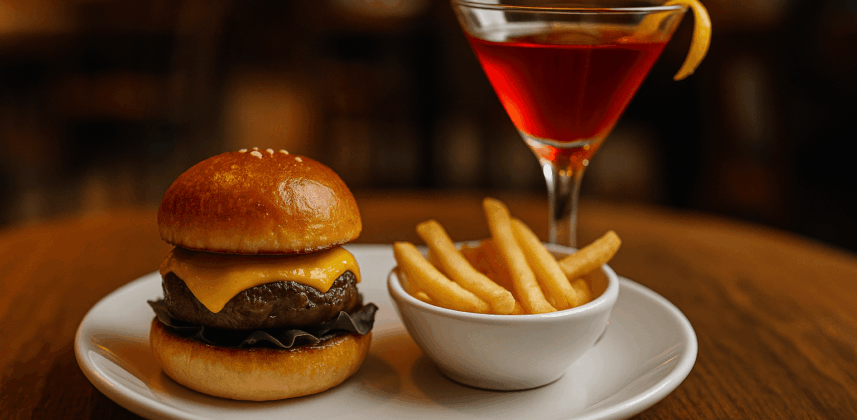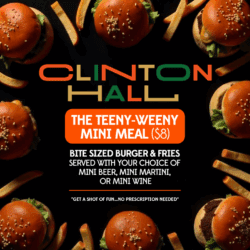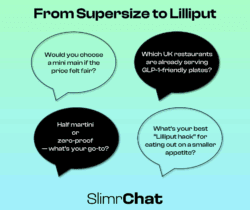The end of supersize? US is rolling out “Ozempic Meals”
Peter Paumgardhen | Last update: 16th August 2025
America is quietly swapping supersized plates for smaller portions. From mini mains and half martinis to smoothie menus built for smaller appetites, US restaurants are adapting fast to the GLP-1 era. With higher obesity rates, greater user penetration, famously larger default portions they are further along the curve. What does that mean for us in the UK? Meal size shrinkflation, protein-first mini options, fair pricing and less waste? All whilst keeping the joy of eating out? Here’s the trends, the signals on how UK dining could get more GLP-1-friendly

TL;DR
- USA restaurants and bars are adding mini mains and half-size cocktails to suit GLP-1-shaped appetites, with some reporting strong interest in these downsized options.
- 1 in 10 of Americans are already on weight loss treatments, 3 in 10 say they’re interested. Users report lower food spend on average. This is a big signal for hospitality.
- US is ahead of the UK: higher baseline obesity, higher GLP-1 penetration, and the large portion culture of larger default portions make “mini” an obvious move.
- Early days in the UK but hints exist (London’s Otto’s has a “menu for one, small appetite”), but the mainstream shift is still to come.
- Expect mini mains, protein-first small plates, half martinis and more explicit menu entries. Hopefully priced reasonably and done without stigma.
The cold open: lunch with Gulliver
Touch down in New York, order a burger, and what arrives looks… adorable. Two polite bites of burger, a small constellation of chips, and a drink you could finish in three sips. You haven’t been transported to a theme park. You’ve arrived in the era of the Ozempic meal, where restaurants are right-sizing plates for people whose appetites have changed on GLP-1 medications. Think Lilliput, not Supersize Me. And before we go further: this is an article about behaviour and hospitality, not medical advice.
What’s actually happening in the US
 In April, NYC sports-bar chain Clinton Hall launched its “teeny-weeny mini meal”: less than $10 for a bite-size burger, fries and drink. Literally an “adult kids’ meal.” The owner created it after watching friends on GLP-1s take a couple of bites and leave the rest, worrying about food waste and diners feeling short changed. Early reactions suggest the mini-meal is working with GLP-1 users who find it fits their new smaller appetite.
In April, NYC sports-bar chain Clinton Hall launched its “teeny-weeny mini meal”: less than $10 for a bite-size burger, fries and drink. Literally an “adult kids’ meal.” The owner created it after watching friends on GLP-1s take a couple of bites and leave the rest, worrying about food waste and diners feeling short changed. Early reactions suggest the mini-meal is working with GLP-1 users who find it fits their new smaller appetite.
This isn’t just one quirky special. Snack-board and aperitivo-style options are spreading (Lulla, The Alderman), pitched with the same matter-of-fact tone venues use for vegetarian or vegan needs: “Is there something for me here?” Bars are also trimming glassware: mini martinis and “snaquiris” (yes, that’s a tiny daiquiri) have popped up, with some lounges offering $9 “mini-martini hour” prices. One Manhattan bar now sells dozens of half martinis weekly.

Even chains are in. Smoothie King transitioned from an app-only “GLP-1 support menu” to a prominent in-store placement, featuring higher protein/fibre, lower sugar, and clearly labelled options. Users describe it as “validating”. More options, less fuss.
The Swedish press is clocking the same pattern. “Ozempic meals” as a discreet way to keep diners coming while cutting both food waste and the social awkwardness of leaving half a plate untouched.
Why is the US ahead?
Three forces make the States a natural early mover:
Penetration: it’s large motivated user base. 1 in 10 of Americans are already on weight loss treatments, 3 in 10 say they’re interested. This is up t0 100 million people for restaurants and venues to go after.
Portion culture: anyone who has eaten out in the US knows the default serving is… generous. Shrinking from “American large” to “sensible small” is a much bigger lever than here.
Behavioural economics: those of us on GLP-1s have lower spend on food, fewer sweet/salty snacks, and less alcohol. If venues don’t change what they offer and serving sizes, they risk losing business.
As Dana Gunders of ReFED put it, we’ve moved from a niche of people who “eat like birds” to a market segment actively wanting smaller portions. Restaurants that feed that demand can win.
“Shrinkflation,” but make it consensual
We’ve all groaned at paying the same for fewer crisps. This is different: you pay less for less on purpose. A smaller plate where the value comes from how well it suits your appetite, not how much it weighs. And the price should match the portion. No charging full-meal prices for something that’s gone in two bites.
“After years of massive burgers, we might be ready for a Lilliput lunch.”
Early signs
We’re not at a US-style tipping point yet, but the clues are there. London’s Otto’s quietly introduced a “menu for one, small appetite” tasting: quality intact, portion sizes recalibrated, and crucially, no need to explain why you want it. That’s elegant hospitality design with dignity.
Culturally, the UK already embraces sharing plates, half-pints, and the time-honoured “fancy splitting a pud?” Expect the trend to present here as better-labelled small plates and mini mains, not a wholesale rebrand to “GLP-1 menus.”
What we could see next…
Menus & pricing
Protein-first minis: grilled fish or chicken, legumes and leafy sides, plus high-fibre swaps. Labelled as flavour-forward, not “diet food.”
Mini mains & bundles: let guests build three small plates instead of one heaving platter; price the trio like a main, not three starters.
Half serves behind the bar: half martinis, smaller wine pours as standard, and zero-proof lists that feel grown-up.
Leftovers without side-eye: normalise take-home boxes; it’s sustainability as much as satiety.
Labelling & experiences
Icons over lectures: a simple protein/fibre/mini symbol beats an essay.
Pacing as a feature: slow the speed between courses so we feel hungry. Hospitality, not hectoring.
Where it starts
Coffee and smoothie chains (the Smoothie King playbook will be studied).
Fast-casual and pubs with flexible kitchens that can portion cleanly.
Supermarkets and ready-meal brands testing nutrient-dense “minis.” PwC’s data suggests that the winners will prioritise function (protein, fibre, micronutrients) when volume decreases.
Social well-being (this really matters)
Going out isn’t just about calories; it’s community, birthdays, first dates, Tuesday night catch-ups. If a changed appetite makes you avoid restaurants, something precious is lost. Operators can keep the door open:
Offer minis by default (not by special request).
Let people split mains for a small fee, without judgment.
Make zero-proof and half-serves feel premium with beautiful glassware, proper garnishes.
Price fairly: as one NYC operator said, “Just because you’re on this medication doesn’t make you rich.”
For guests, a simple playbook helps: mini where possible, protein first, fibre on the side, sip slower, share more. That’s not dieting — that’s dining that fits.
Not everyone will change
Some full-service venues report little impact; people come for the experience. They want the pasta, the wine, the theatre of it all and they aren’t asking for smaller plates. Not every restaurant must change, but that choice should exist across the high street.
The business case in one graphic (if we had one…)
Demand: 1 in 10 using; 3 in 10 interested
Behaviour: lower food spend; fewer snacks; some reduce alcohol.
Hospitality’s response: mini mains, snack boards, half cocktails; app-to-in-store GLP-1-support menus.
Equity & dignity: smaller, priced right, and no stigma.
Is it “shrinkflation 2.0” time?
Maybe. Imagine menus where every dish has a little cousin: same flavour, half the heft, half the price. A credible “mini main” could become the default for a portion of the market, just as veggie once moved from the margin to the middle. This vibe might feel surprisingly… comfortable.
Join the SlimrChat discussion
We’d love to hear your thoughts in the SlimrChat Forum:
Would you choose a mini main if the price felt fair?
Which UK restaurants are already serving GLP-1-friendly plates and deserves praise (or a gentle nudge)?
Half martini or zero-proof? What’s your plan?
What’s your best hac for eating out on a smaller appetite?

Share your ideas and see what others are saying.
Sources & further reading
The New York Times: reporting from New York venues on mini meals, mini martinis, and chain responses; includes estimates such as ~25% of diners choosing mini versions at some sites.
Svenska Dagbladet: Swedish overview of the “Ozempic meals” trend referencing NYC examples and consumer reactions.
PwC (Oct 2024) GLP-1 Trends & Impact Survey: 8–10% US usage, 30–35% interest, ~11% lower food spend, and cross-sector implications.